Cornhusker Economics Jan. 4, 2023
Role of Social Network on Technology Adoption: Application to Nebraska Producers in the Face of Undesirable Vegetation Transitions
Introduction:
In recent years, the world's physical and biological systems have gone through drastic undesirable transitions affecting aquatic habitat, water resources, and agricultural productivity of rangelands, forests, and other ecosystems (Stefen et al., 2015). Undesirable Vegetation Transitions (VTs) occur in different biomes due to climate change, and anthropogenic activities, such as those involving lack of suitable land management practices. According to a USDA report from 2010, invasive plants have covered half of the non-federal rangelands adding up to more than 50% of the plant cover in 6.6% of these lands. Damage and control costs linked to these invasive species are estimated to cost the global economy $1.4 trillion in losses yearly, which is nearly 5 percent of the global economy. The cost of these damages in the United States is $137 billion annually (Pimentel et al., 2000; Pimentel et al., 2014). The rangelands in the state of Nebraska (NE) face undesirable VTs due to social-ecological interactions (between trees and producers), which are responsible for the shift from grassland to woody plants (Engle et al.,2008). Considering the intensity of damage associated with the VTs, Uden et al. (2019) have developed a screening and imaging tool that links spatial resilience theory with computational techniques to detect undesirable VTs responsible for affecting rangelands' productivity and generated ecosystem services. This new technology, if adopted by producers, could lead to significant environmental improvements on rangelands owing to producers being able to anticipate VTs and taking actions on their operations to apprehend/address them. However, there is limited knowledge regarding the degree to which producers would be willing to adopt any technology in general and this screening tool in particular.
Thus, this paper (using survey data) looks at the issue of producer likelihood to adopt with a focus on Nebraska producers with specific attention to the role of information obtained through their social networks on willingness to adopt. Additionally, we also focus on producer's willingness to seek information about a new technology which is an essential step prior to making a decision to adopt the new technology. We are interested in social networks given the extensive research showing the potential effects of social networking on technology adoption in a variety of contexts such as the adoption of high-yield seed varieties (Foster & Rosenzweig, 1995), a new crop variety (Bandeira & Rasul, 2006), the adoption of pineapple production technology (Colney & Udry, 2004), new groundwater extraction and irrigation techniques (Genius et al., 2013), conservation land management (Kolady et al., 2021) and crop rotation practices (Che et al., 2022), and the limited application of this aspect to study producer decision making with respect to VTs.
Survey Design and Variables:
To examine the effects of social network measures, we developed a survey questionnaire which was fielded to a sample of producers (ranchers and farmers) who own land equal to or greater than 20 acres in selected counties in NE experiencing undesirable VTs due to encroachment of woody plants onto grass dominated land (see Fig. 1). Information identifying potential survey respondents was purchased from the profit company Farm Market ID which curates, cleans, and produces names, addresses, and operation information from the USDA NASS.
The survey included a letter describing the purpose of the survey, IRB approval information, voluntary nature of participation, and statement of confidentiality of the survey responses received. We implemented the Dillman survey administration method (Dillman et al.,2014) in mixed mode (both online and paper) and sent out the survey between June 2021 and July 2021. A total of 570 respondents (out of the 4500 who received the survey) completed and returned the questionnaires. The overall response rate was 13%.
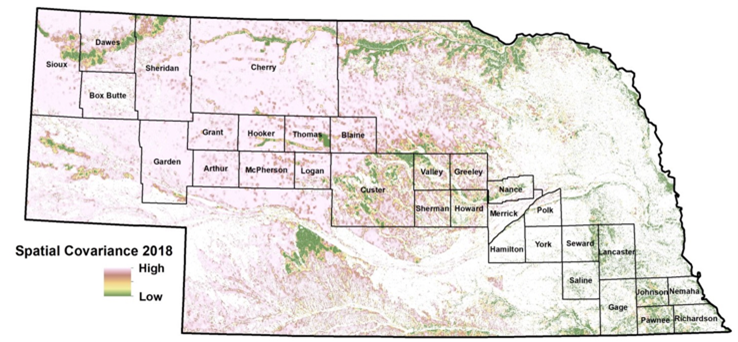
The questionnaire included three main sections: i) operation (farm and ranch) and producer characteristics, ii) attitudinal questions pertaining to VTs, and iii) questions focused on identifying the social network of each respondent along with key network-based information variables. In the first section, we included variables Age, Education, Total acreage, and Intensity of vegetation transitions experienced by the respondent. We kept Age variable as an open-ended question in the survey, Education measured the highest level of completed education, categorized using 1 = “less than high school,” 2 = “high school,”3 = “some college/technical school,” 4 = “4‐year college degree,”5 = “Masters’ or Doctoral degree.” Variables that capture operation characteristics included the Total acreage of owned and rented land. The Intensity of VTs within a 10 km radius of the producers’ address was measured using geo-spatial data. Table 1 presents the summary for demographic variables used in the analysis.
We included several questions on Risk Attitude, Risk Perception, Perception of VTs and Spillover Effects to assess respondents’ attitude towards risk and undesirable VTs, in the second section. We assessed risk perception of respondents regarding VTs based on three different dimensions – threat of VT to ecosystem services, to operation-level profitability, and overall operation productivity. Spillover effect refers to change in a respondent’s behavior after observing incidence of VT from the environment around him or leaning about it from his social network. Each question was assessed using five-point Likert-type questions (1=strongly disagree to 5= strongly agree).
Social Network Metrics Construction:
To elicit the data on producers’ social network, we followed three steps: First, we used a name generator question to identify each respondent’s network contacts: (e.g., “Please list the names of people with whom you work on your operation, communicate about your operation, and seek advice for rangeland management and operation). The focus of the analysis of our study was personal networks of each respondent, which is known as an ego network. An ego network is defined as a segment of a social network formed by an individual, known as ego (Arnaboldi et al., 2016). Going forward, we will use the term ego to identify respondents and alter to identify the respondents’ network contacts. Second, each ego answered several follow-up questions to elicit network composition constituting alters’ occupations, length of time each alter was known, frequency of interaction with each alters, and types of information received from each alter.
To estimate the ego’s social network measures metrics focusing on Occupation Heterogeneity in ego’s network, Information Heterogeneity measuring the heterogeneous profile of information ego receives from his network, and Network Efficiency, Frequency of Interaction with alters, and Ego Network Density was computed using the E-Net software (Borgatti, 2009). The multiple heterogeneity measures range between 0 and 1 with a value of zero representing receipt of less diverse information from alters and a value of one representing information obtained with highest diversity. To measure the efficiency of the social network structure of each ego, we used E- Net to get a measurement on the incidence of structural holes. A structural hole is conceptualized as any empty space between two individuals in the social network (Burt, 1992). For our context, to understand whether the information ego gets from his social network is new or redundant it is important to elicit the structural hole efficiency measure of social network structure. E-Net computes structural hole efficiency measure between zero and one with a value “1” implying that the network structure is maximally efficient with there being non-redundancy of information received from alters and a value of zero signifies that the information ego gets from his network is not efficient implying presence of structural holes and redundant information.
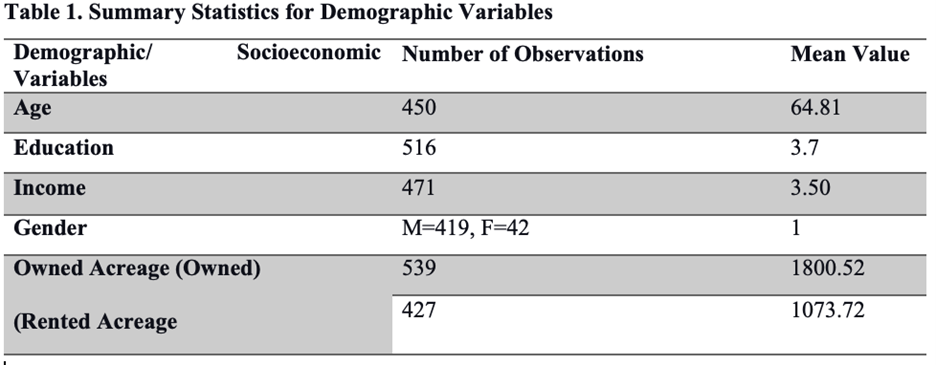
Results:
We have organized our results into a study of general willingness to seek new information followed by a likelihood of adopting the new screening technology. The description of results below focuses on ego’s social network measures that have a significant and non-significant impact on dependent variables. Further, the description of the results for attitudinal and demographic variables is only specific to only significant variables.
Table 2 presents the estimates for the willingness to seek information regarding new management practices and technologies using an ordered probit regression analysis. The dependent variable in these regressions is “willingness to seek information” that takes integer values between 1 and 5 with 1 representing low willingness and 5 representing high willingness. Results for multiple models are presented which differ on the basis of the inclusion of the social network metrics. We controlled for each social network measure separately due to high multi-collinearity between social network variables, while attitudinal and demographic variables are same in all models.
The estimates for social network variables in each model show that there is no significant relation between each social network measure and the willingness to seek information. However, in models 1, 4, and 5 we observe that individuals with high-risk attitude have higher willingness to acquire information at 5% level of significance. Similarly, the spillover effect has a significant positive effect on the willingness to seek information in all five models at 1% level of significance. This provides evidence that when a producer observes the sign of VT on his neighbor’s land his willingness to seek information about new technologies and practices which can help him manage his land to mitigate the likelihood of VTs. Moreover, the demographic variable for education with a negative and significant effect shows that with increase in the level of education a producer’s willingness to seek information decreases.
Results for the likelihood of technology adoption are presented in Table 3. The dependent variable for the results of the ordered probit regression is “likelihood of adopting screening and imaging technology” and it takes values between 1 to 5 with 1 representing “less likely to adopt screening technology” and 5 representing “more likely to adopt screening technology”.
The coefficients for social network measures show that occupation heterogeneity, frequency of interaction, and network density has a significant and positive effect on the likelihood of technology adoption at 10%, 5%, and 1% level of significance, respectively. In contrast, the network efficiency measure has a significant and negative effect on the likelihood of technology adoption at 1% level of significance. These results provide evidence that social network composition significantly influences producers’ likelihood of adoption of screening technology. However, with increase in the network efficiency and exchange of more varied (and hence less redundant) information, the likelihood of screening technology adoption decreases.
The coefficient for the risk attitude variable in columns 1, 2, 4, and 5 suggests that producers with higher risk attitudes are more likely to adopt the technology. In addition, the spillover effect again leads to a positive significant relation, implying that the effect of observing VTs on neighbor’s land increases the producer’s likelihood of adopting screening and imaging technology. The estimate for the demographic variable education is positive and significant, indicating that producers are more likely to adopt screening and imaging technology, with the higher education estimate for age variable is negative and significant, implying that older producers are less willing to adopt the new technology. Finally, the greater the managed acreage, the higher is the producer’s likelihood of adopting the screening technology.
The bottom five rows of Table 3 present the results for the interaction effects between risk attitude and each social network measure. For instance, fig 2a shows that with a high-risk attitude, producers having highly efficient networks are less likely to adopt screening technology than producers with low efficient networks. Likewise, fig 2b demonstrates that producers with high risk-attitude and having more frequent interactions with their alters are more likely to adopt screening technology than producers who interact with their alters less frequently.
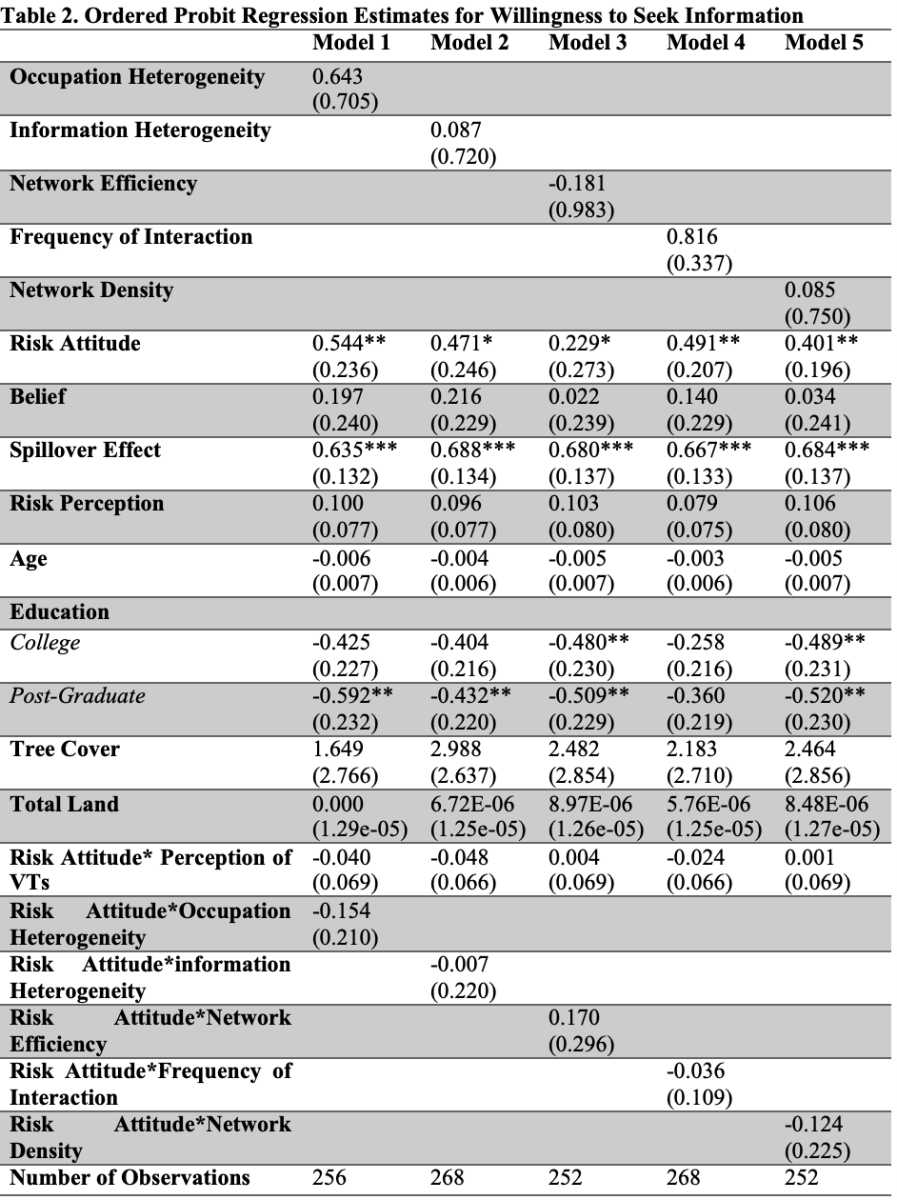
Table 3. Ordered Probit Regression Estimates for The Likelihood of Technology Adoption
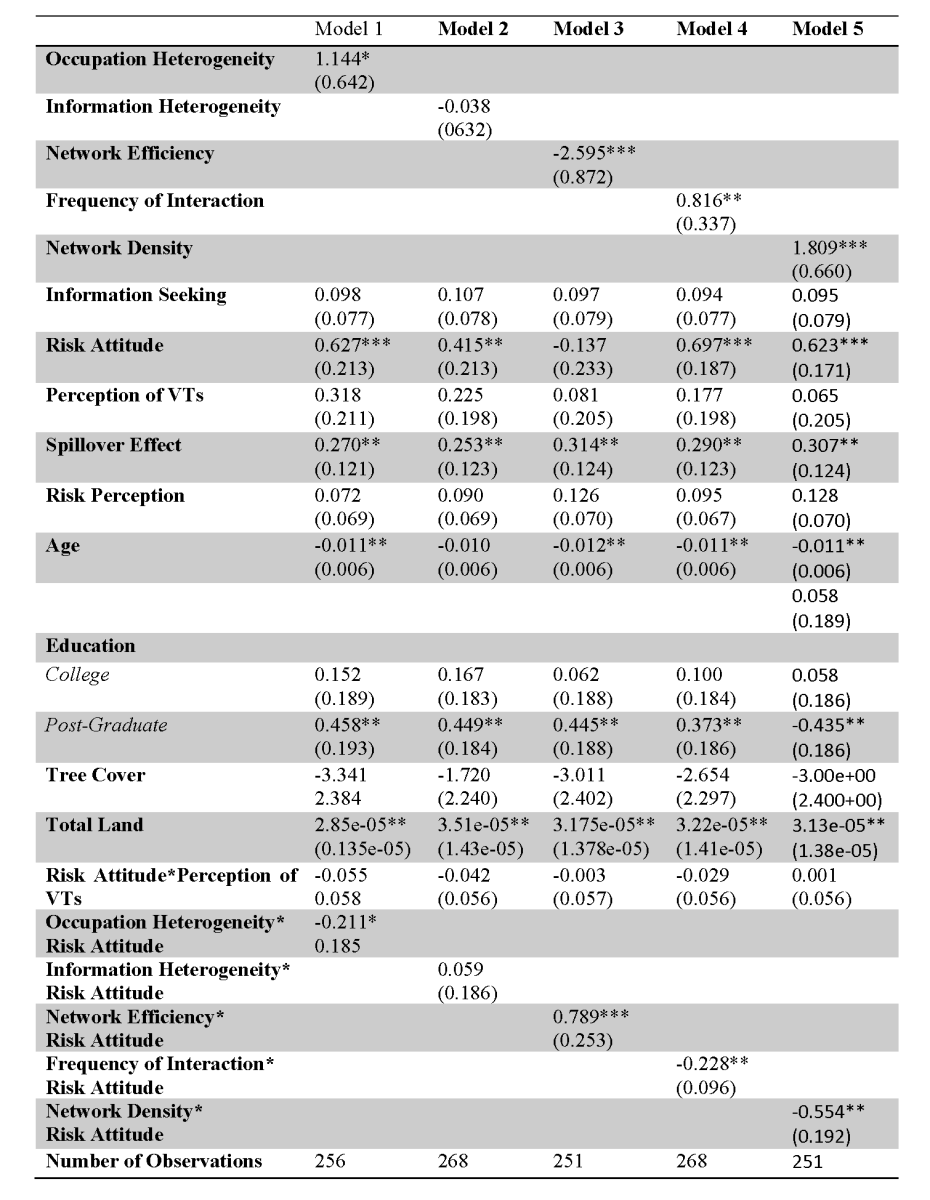
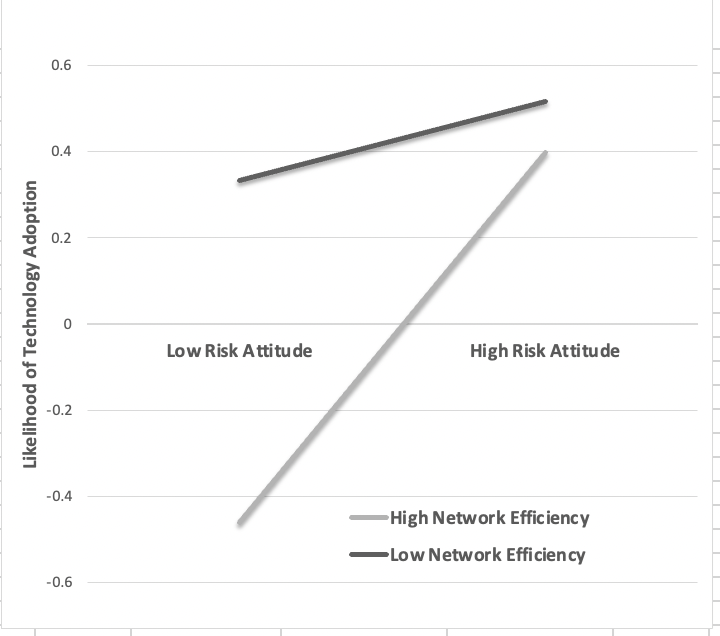
a
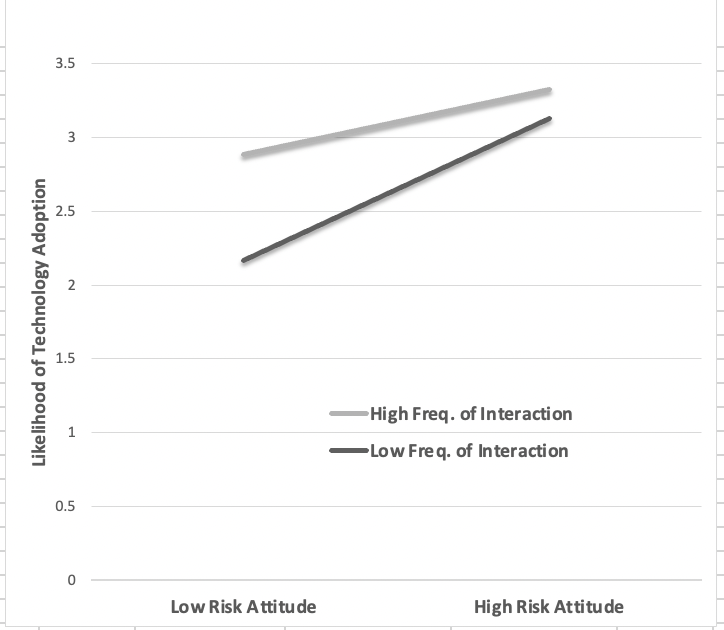
b
Fig 2. Interaction Plots: a) Interaction between Risk Attitude and Network Efficiency
b) Interaction between Risk Attitude and Frequency of Interaction
Conclusion:
Producers need to have access to information regarding new conservation practices and technologies to ensure land management in the face of ecological threats in general and VTs in the context of our study. This study investigates the role of an individual producer’s social network on the willingness to seek information about technologies and management practices and the likelihood of new technology adoption with special attention to risk attitudes and producer spillover effects. Our results provide evidence that network composition and information obtained through a producer’s social network don’t influence an individual’s willingness to seek information about new technologies or management practices. However, when it comes to adopting specific technology, like screening and imaging technology, social network measures have a significant impact. Additionally, we found risk attitude and spillover effect positively influence the likelihood of technology adoption. The significant positive impact of the spillover effect confirms that producers are reactive to the effects of VTs that they observe within their neighbor’s land and are willing to seek information regarding new practices and technologies and adopt them.
Considering the above results, it is evident that if public and private agencies are interested in addressing negative effects of VTs through changes in producer behaviors, they would be well served to invoke the mechanism of producer personal social networks to ensure effective receipt and dissemination of information regarding the new technology. Such effective information transmission can be combined with existing (and new) environmental policies to address VTs issues in Nebraska (and possibly in other areas where producers have similar profiles).
Acknowledgement
This study is based upon work funded by the National Science Foundation’s Established Program to Stimulate Competitive Research (EPSCoR) under Grant No. 1920938. The findings, and conclusions or recommendations expressed in this material are those of the author(s) and do not necessarily reflect the views of the National Science Foundation.
References
Arnaboldi, V., Conti, M., La Gala, M., Passarella, A., & Pezzoni, F. (2016). Ego network structure in online social networks and its impact on information diffusion. Computer Communications, 76, 26-41.
Borgatti, S.P. (2006). E-NET Software for the Analysis of Ego Network Data.
Burt, R. S. (1992). Structural holes. Harvard university press.
Dillman, D. A., Smyth, J. D., & Christian, L. M. (2014). Internet, phone, mail, and mixed-mode surveys: The tailored design method. John Wiley & Sons.
Engle, D. M., Coppedge, B. R., & Fuhlendorf, S. D. (2008). From the dust bowl to the green glacier: human activity and environmental change in Great Plains grasslands. In Western North American Juniperus Communities (pp. 253-271). Springer, New York, NY.
Foster, Andrew D., and Mark R. Rosenzweig. 1995. “Learning by Doing and Learning from Others: Human Capital and Technical Change in Agriculture.” Journal of Political Economy 103(6): 1176–209.
Isaac, M. E., & Matous, P. (2017). Social network ties predict land use diversity and land use change: a case study in Ghana. Regional Environmental Change, 17(6), 1823-1833.
Kolady, Deepthi, Weiwei Zhang, Tong Wang, and Jessica Ulrich‐Schad. 2021. “Spatially Mediated Peer Effects in the Adoption of Conservation Agriculture Practices.” Journal of Agricultural & Applied Economics 53(1): 1–20.
Graham, N. A., Bellwood, D. R., Cinner, J. E., Hughes, T. P., Norström, A. V., & Nyström, M. (2013). Managing resilience to reverse phase shifts in coral reefs. Frontiers in Ecology and the Environment, 11(10), 541-548.
Loevinsohn M, Sumberg J, Diagne A (2012) under what circumstances and conditions does adoption of technology result in increased agricultural productivity? Protocol. London: EPPI Centre, Social Science Research Unit, Institute of Education, University of London.
Mwangi, M., & Kariuki, S. (2015). Factors determining adoption of new agricultural technology by smallholder farmers in developing countries. Journal of Economics and sustainable development, 6(5).
Pimentel, D., Lach, L., Zuniga, R., & Morrison, D. (2000). Environmental and economic costs of nonindigenous species in the United States. BioScience, 50(1), 53-65.
Pimentel, D., & Burgess, M. (2014). Environmental and economic benefits of reducing pesticide use.
Steffen W, et al. (2015b) Planetary boundaries: Guiding human development on a changing planet. Science 347(6223):1259855. Integrated Pest Management (pp. 127-139). Springer, Dordrecht.
Udry, C.R. and T.G. Conley, 2004. Social networks in Ghana. Center Discussion Paper No. 888, Economic Growth Centre, Yale University.
Uden, D. R., Twidwell, D., Allen, C. R., Jones, M. O., Naugle, D. E., Maestas, J. D., & Allred, B. W. (2019). Spatial imaging and screening for regime shifts. Frontiers in Ecology and Evolution, 7, 407.
Wossen, T., Berger, T., & Di Falco, S. (2015). Social capital, risk preference and adoption of improved farmland management practices in Ethiopia. Agricultural Economics, 46(1), 81-97.
Sabrina Gulab
Graduate Research Asst
Department of Agricultural Economics
University of Nebraska–Lincoln
sabrina.gulab@huskers.unl.edu
Holly. K Nesbitt
Postdoctoral Researcher
Department of Human-Environment Systems
Boise State University
holly.nesbitt@umconnect.umt.edu
Simanti Banerjee
Associate Professor
Department of Agricultural Economics
University of Nebraska–Lincoln
simanti.banerjee@unl.edu
Theresa Floyd
Associate Professor
School of Business Administration
University of Montana
theresa.floyd@umontana.edu
Karina Schoengold
Associate Professor
Department of Agricultural Economics
University of Nebraska–Lincoln
kschoengold2@unl.edu